Fiber
Optics
A
New Approach to Monitor and Control Process Temperature The coupling
of optical fibers to infrared detectors and signal processing
electronics represents the latest progress in the field of non-contact
temperature measurement and control. Only recently have fiber
optics become the object of widespread interest thanks mainly
to their ability to carry optical information signals over long
distances and around unavoidable obstructions.
For
years infrared detectors have been used in conjunction with conventional
optical elements (lenses, mirrors, prisms). Fiber optics were
excluded from consideration since they are made of either glass
or plastics, both of which are opaque throughout most of the infrared
spectral region. Thus, according to fundamental laws of physics,
their marriage to infrared detectors could never work.
Months
of painstaking development proved the reality and practicality
of transmitting IR with fiber optics. And thus it happened that
coupling fiber optics with infrared detectors resulted in several
new families of instrumentation and control systems endowed with
superior performance characteristics.
Since
most if not all of you are currently familiar with the theory
of infrared radiation and the variety of methods for monitoring
IR this discussion will deal mainly with the application of fiber
optics in conjunction with IR detectors, i.e. their construction,
advantages, disadvantages and applications.
A
typical optical fiber is usually constructed of a silicon (glass)
material, however, plastic and quartz are also available but normally
for data transmission. Today most of all optical fibers manufactured
consist of a light-conducting glass core surrounded by a thin
layer of glass cladding with a lower refractive index. This cladding
serves to protect the core finish. All fibers used in infrared
instrumentation are made of glasses especially chosen for their
ability to transmit the radiation comprised in the chosen spectral
region. All rays entering the front surface that acquire an inclination
smaller than the critical angle are totally reflected inside the
fiber core, and keep propagating in this fashion until they reach
the opposite end or are totally absorbed, whichever comes first.
For a fiber having a critical angle of X° means that all rays
incident onto the fiber's front surface at the same angle or less
with its axis are trapped inside the fiber by total internal reflection.
On
the other hand, all incident rays entering the fiber with an inclination
larger than the same angle will leave the first contact with its
internal surface. This behavior is commonly called "spilling"
(See Figure 1).
 The
value of the critical angle is a function of the ratio between
the refractive indexes of the glass of which the core is made
and of the medium surrounding it. By controlling the ratio we
can increase or decrease the acceptance angle of fiber optics,
thus obtaining special performance characteristics.
The
value of the critical angle is a function of the ratio between
the refractive indexes of the glass of which the core is made
and of the medium surrounding it. By controlling the ratio we
can increase or decrease the acceptance angle of fiber optics,
thus obtaining special performance characteristics.
For
most IR monitoring applications, optical fibers are assembled
into fiber bundles consisting of many hundreds of individual fibers
contained within a flexible or rigid sheathing of either metallic
or nonmetallic material. Each end of the bundle is held in place
using a high temperature epoxy. The end surface is then highly
polished to assure a clearly defined angle of acceptance and diminish
reflectance losses due to irregular surfaces. Using such a large
number of narrow fibers in a bundle allows us to gather and transmit
more signal to the detector while retaining mechanical flexibility.
Typically, the outside diameter of a single fiber is 25m.
Generally
speaking, in the majority of applications where optical fibers
are used with infrared radiometers, the lengths are 1 or 2 meters
long. On occasion fibers will be made up to approximately 10 meters
in length.
The
determining factors in using fiber bundles to transmit IR, are
MMT (minimum measurable temperature), target distance and spot
size. The higher the temperature the longer the fiber, conversely
low temperatures require a shorter fiber due to the glass attenuation.
Unfocused
fibers those without a viewing lens) have a field of view or angle
of acceptance of 60°. This is the target area viewed by the detector
which is slightly larger than the distance between the front end
of the fiber and the target surface. This can be easily verified
by backlighting the target with visible light which will project
onto the target surface. Unfocused fibers are used when the target
area is large and it is desirable to measure its average temperature.
Focused
fibers (those with a viewing lens assembly attached to the front
end) are used to measure targets as small as .01 cm from as far
away as 4.5 meters or further. The determining factor as with
fiber length is the amount of energy being collected. By backlighting
we can be assured the lens is properly focused and aligned on
the target. In some applications, where vibration or other type
movement may alter the lens's alignment, a bifurcated fiber is
preferable. One branch of the fiber is connected to a high intensity
light source and activated by a momentary-on switch which will
verify to the operator the correct alignment of the fiber. The
other branch will allow the infrared detector to "see" the target
at exactly the same spot that was illuminated.
Figure
1 Figure 2: Monitoring steel rod continues induction heating.
Figure 3: Controlling induction treating of automotive crankshafts.
Figure 4: Five-channel multiplexing, signal-processing and display
system. Figure 5 Figure 6 Figure 7 Figure 8 Figure 9 Figure 10
Fiber assembly varieties The wide selection of fibers and lens
configurations available allows for a satisfying and endless number
of applications.
Following
are some of the many components that make up a fiber optic system
and allow for such versatility.
Sheathing
- Single, bifurcated or trifurcated fiber optic systems
- Flexible stainless steel (standard)
- Heavy duty S.S. wire braid
- Heavy duty braided fiber Imperial Eastman
- Teflon (for use in high RF fields)
- Protective tubing
Lenses
- 1.27 cm, 1.90 cm, 2.54 cm x 8.59 cm to 27.7 cm max.
- Natural - black anodized aluminum
- Angular lens configurations available
Replaceable
Tips
- Glass or quartz, 7.62 cm, 15.24 cm & 22.86 cm long
- Ceramic or stainless steel jacket Optical Rods - Glass, 15.24
cm, 30.48 cm & 60.96 cm long - Ceramic or stainless steel jacket
Specials - Right angle prisms, high speed scanners, angled bundle
configurations Applications.
Since
virtually every manufactured product - from automobiles to the
safety pin - requires the application of heat treatment in some
form, the use for non-contact temperature monitoring and control
is virtually limitless.
 Induction
Heating
Induction
Heating
Because of the strong RF inductive energy field needed to heat
the metal parts being treated, conventional measuring devices
are of little value since they will be heated directly by the
induction coil.
Figures
2 and 3 show typical applications of fiber optic systems used
to monitor and control induction treatment of metal objects either
stationary in, or moving through induction furnaces. Precise control
of the temperature needed for perfect heat treatment of metal
parts is essential to produce the crystal structure that will
ensure meeting or exceeding the mechanical characteristic specifications.
This control function is achieved either by on/off or high speed
proportional control incorporated in the fiber optic and Thermal
Monitoring System. Using fiber optics vs. the conventional direct
line of sight infrared detection systems allows placing the viewing
end of the fiber optic in close proximity of the target. The tip
of the fiber in many cases may be positioned between the induction
coils to view the processed material. To eliminate the adverse
effects of the RF field a ceramic replaceable tip is utilized.
In those instances where the design of the system won't allow
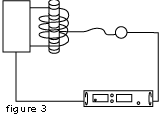 room
for the fibers, a lens system will then be provided to view and
monitor targets from a distance.
room
for the fibers, a lens system will then be provided to view and
monitor targets from a distance.
The
fiber and electronics normally are not affected by induction energy
fields, however, in unusual circumstances when the electrical
noise environment is excessively high, a synchronous demodulation
system is specified. The sync. demod, converts the 400 Hz AC signal
from the detector head to DC. This conversion differs from conventional
AC to DC converters in that it selects only the signal component
at 400 Hz and discriminates against noise components of other
frequencies.
 Continuous
Casting These operations utilize fiber optic assemblies up to
thirty feet in length that are installed between the rollers themselves
to within one or two inches of the slab surface. A remotely located
automatic multiplexing chassis monitors several points on a time
shared basis, achieving significant savings in terms of cost and
space. Due to the shielded path of constant transmissivity provided
by the optical fibers and the short wave length 0.8 to 1 silicon
detector, the system "watches" the target through smoke, fumes,
vapors and water. (See Figure 4.) Quite often in this type of
application the fibers are exposed to substantially elevated temperatures
and mechanical abuse necessitating the need for air purging and
special heavy duty protective sheathing. The purge tube is designed
to allow the air flow to exit the front end of the fibers at a
right angle thus preventing the build up of contaminants. Metal
Forging, Hot Stamping, Pipe Bending Forging of metal parts includes
both rough shape as well as precision forging, which requires
less material removal and waste. Pipe bending and shaping is also
included in this application. These operations are carried out
by heating the parts to be worked upon to the optimum temperature
with any of the several means available (ovens, flame, induction
field, etc.) If the part temperature is below the optimum, cracks
and internal tensions will develop, while if it is above the optimum,
drooping will take place. The precise temperature control afforded
by the use of infrared fiber optic controllers will:
Continuous
Casting These operations utilize fiber optic assemblies up to
thirty feet in length that are installed between the rollers themselves
to within one or two inches of the slab surface. A remotely located
automatic multiplexing chassis monitors several points on a time
shared basis, achieving significant savings in terms of cost and
space. Due to the shielded path of constant transmissivity provided
by the optical fibers and the short wave length 0.8 to 1 silicon
detector, the system "watches" the target through smoke, fumes,
vapors and water. (See Figure 4.) Quite often in this type of
application the fibers are exposed to substantially elevated temperatures
and mechanical abuse necessitating the need for air purging and
special heavy duty protective sheathing. The purge tube is designed
to allow the air flow to exit the front end of the fibers at a
right angle thus preventing the build up of contaminants. Metal
Forging, Hot Stamping, Pipe Bending Forging of metal parts includes
both rough shape as well as precision forging, which requires
less material removal and waste. Pipe bending and shaping is also
included in this application. These operations are carried out
by heating the parts to be worked upon to the optimum temperature
with any of the several means available (ovens, flame, induction
field, etc.) If the part temperature is below the optimum, cracks
and internal tensions will develop, while if it is above the optimum,
drooping will take place. The precise temperature control afforded
by the use of infrared fiber optic controllers will:
-
Avoid the formation of defective parts (from cracks or drooping),
thus eliminating rejects and waste due to these defects;
- Save thermal energy by ensuring that no heat is wasted by heating
the parts beyond the optimum level;
- Speed up production by allowing a faster rate of heating the
parts without danger of temperature overshoot.
Metal
Die Casting
The die temperature is of critical importance in die casting of
metals. Thermal cycling of aluminum products, with reference to
die temperature has been successfully implemented with the help
of optical fibers. Figure 5 shows schematically and in detail
how the front end.
 of
the fiber is inserted through the mold frame and held in a corner
of the runner plate, in contact with the aluminum flowing through
it.
of
the fiber is inserted through the mold frame and held in a corner
of the runner plate, in contact with the aluminum flowing through
it.
The
major advantages offered by this solution are:
- Substantial savings of thermal energy, by eliminating overheating
and drastically reducing production rejects.
- Increased production due to the speedup of the casting cycle.
The operation is automatically controlled by the temperature of
the casting material and not solely by time, resulting in faster
operation.
- Improvement in the quality of the casting due to the control
of the process as a function of temperature, results in simpler
operation and automatic compensation for a cold die start-up or
interrupted cycles.
Direct indication of the die and furnace pot temperature of the
metal. Low level and blocked water lines are easily indicated
several shots before the casting can display conditions visibly.
Control
of Metal-Working Laser
Lasers, generally high-power CO2 lasers, are used for welding,
surface treating and finishing metals of various types. The conventional
approach is to periodically sample the beam to keep its power
at the desired level. This approach, however, cannot automatically
take into account the emissivity variations of the target surface.
These variations, in turn, affect the amount of laser power absorbed
by the target, and consequently the target's temperature, which
is of paramount importance for good operating performance.
This difficulty is overcome by the use of an emissivity-independent
infrared fiber optics system (EITM) aimed at the spot of laser
beam impact. (See Figure 6.) The infrared
 system
is made blind to the laser wavelength, and in this way it measures
precisely the target temperature at the same spot and, via a feedback
loop, it controls the laser power to ensure that the operation
is carried out at the optimum temperature.
system
is made blind to the laser wavelength, and in this way it measures
precisely the target temperature at the same spot and, via a feedback
loop, it controls the laser power to ensure that the operation
is carried out at the optimum temperature.
Among
the advantages offered by the fiber optics infrared approach are
the following:
- Non-contact temperature measurement in real time.
- Fiber optics allow easy access to view the laser heating area
because of their relatively small size.
- EITM compensates for variations in emissivity as the part is
being heated.
- EITM response can be matched to the response speed of the laser.
Additional applications of interest:
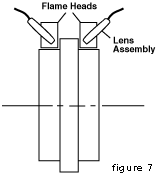 Flame
Cutting
Flame
Cutting
Automated flame cutting involves either pattern tracing or computer
control to repetitively cut steel plates into a variety of shapes.
(See Figure 7.) During start-up, a natural gas or propane flame
heats the metal plate until a "puddle" of molten metal is detected
by the operator; on multiple heat cutters the time may vary between
torches. The puddle having been formed, oxygen is injected into
the gas stream and blows the molten metal through the plate at
which time the cutting cycle begins. If the oxygen is injected
prematurely a defective cut is made leaving an objectionable rough
and wide pitlike depression in the plate.
By
positioning a fiber optic bundle with lens assembly to look through
the "clean" flame at the plate surface, the temperature is monitored
and controlled to maintain the necessary temperature. By multiplexing
and using hi-lo logic with relays tied in series, the oxygen is
not turned on until all setpoints and associated relays are closed,
insuring high quality cuts.
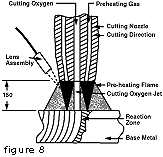 Flame
Hardening of Steel Wheels Hardening the surfaces of steel
wheels used on heavy construction equipment such as drive & idler
wheels for bulldozers, backhoes, and other track type equipment
is presently being accomplished by flame hardening.
Flame
Hardening of Steel Wheels Hardening the surfaces of steel
wheels used on heavy construction equipment such as drive & idler
wheels for bulldozers, backhoes, and other track type equipment
is presently being accomplished by flame hardening.
A flame head is positioned on either side of the wheel (Figure
8). As the wheel is rotated the flame impinges on the surface
elevating the temperature to approximately 976°C. Within close
proximity to the flame the surface is rapidly quenched with cooling
water (Figure 9).
Because of the variations in the wheels, both in roundness and
lateral distortions, if the flame head were fixed the hardening
process would not be uniform throughout the critical areas.
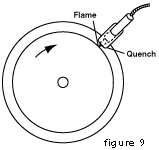 By
optically looking through the "clean" natural gas flame at the
optimum point on the wheel, Figure 10, the variations in the temperature
determined by the Thermal Monitor provide a proportional signal
which is fed to a pneumatic transducer which pneumo/mechanically
moves the head to the correct position. Substantial savings are
realized by eliminating a previous costly process of destructive
testing.
By
optically looking through the "clean" natural gas flame at the
optimum point on the wheel, Figure 10, the variations in the temperature
determined by the Thermal Monitor provide a proportional signal
which is fed to a pneumatic transducer which pneumo/mechanically
moves the head to the correct position. Substantial savings are
realized by eliminating a previous costly process of destructive
testing.
Coke
Guide Pyrometer
By monitoring both level and temperature, the Coke Guide Pyrometer
assures the optimum efficiency in the manufacture of coke. The
multiplexing of several detectors on a vertical plane allows the
operator to measure both height and temperature of the coke in
the processing oven.
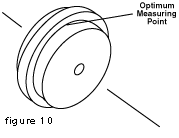 When
desired parameters are met, a controller signal activates the
pusher to dump the processed coke into an awaiting transfer car,
thus assuring a quality product and energy conservation. The above
are but a few of the many and varied uses of fiber optics. The
range and applications for these systems is only limited by one's
imagination. The technology is expanding exponentially. Fiber
optics are no longer viewed with doubts and misgivings. Like IC's,
chips, bubble memories, RAM's, ROM's and PROM's, they are here
to stay, they are the future.
When
desired parameters are met, a controller signal activates the
pusher to dump the processed coke into an awaiting transfer car,
thus assuring a quality product and energy conservation. The above
are but a few of the many and varied uses of fiber optics. The
range and applications for these systems is only limited by one's
imagination. The technology is expanding exponentially. Fiber
optics are no longer viewed with doubts and misgivings. Like IC's,
chips, bubble memories, RAM's, ROM's and PROM's, they are here
to stay, they are the future.
 The
value of the critical angle is a function of the ratio between
the refractive indexes of the glass of which the core is made
and of the medium surrounding it. By controlling the ratio we
can increase or decrease the acceptance angle of fiber optics,
thus obtaining special performance characteristics.
The
value of the critical angle is a function of the ratio between
the refractive indexes of the glass of which the core is made
and of the medium surrounding it. By controlling the ratio we
can increase or decrease the acceptance angle of fiber optics,
thus obtaining special performance characteristics.  Induction
Heating
Induction
Heating  room
for the fibers, a lens system will then be provided to view and
monitor targets from a distance.
room
for the fibers, a lens system will then be provided to view and
monitor targets from a distance.  Continuous
Casting These operations utilize fiber optic assemblies up to
thirty feet in length that are installed between the rollers themselves
to within one or two inches of the slab surface. A remotely located
automatic multiplexing chassis monitors several points on a time
shared basis, achieving significant savings in terms of cost and
space. Due to the shielded path of constant transmissivity provided
by the optical fibers and the short wave length 0.8 to 1 silicon
detector, the system "watches" the target through smoke, fumes,
vapors and water. (See Figure 4.) Quite often in this type of
application the fibers are exposed to substantially elevated temperatures
and mechanical abuse necessitating the need for air purging and
special heavy duty protective sheathing. The purge tube is designed
to allow the air flow to exit the front end of the fibers at a
right angle thus preventing the build up of contaminants. Metal
Forging, Hot Stamping, Pipe Bending Forging of metal parts includes
both rough shape as well as precision forging, which requires
less material removal and waste. Pipe bending and shaping is also
included in this application. These operations are carried out
by heating the parts to be worked upon to the optimum temperature
with any of the several means available (ovens, flame, induction
field, etc.) If the part temperature is below the optimum, cracks
and internal tensions will develop, while if it is above the optimum,
drooping will take place. The precise temperature control afforded
by the use of infrared fiber optic controllers will:
Continuous
Casting These operations utilize fiber optic assemblies up to
thirty feet in length that are installed between the rollers themselves
to within one or two inches of the slab surface. A remotely located
automatic multiplexing chassis monitors several points on a time
shared basis, achieving significant savings in terms of cost and
space. Due to the shielded path of constant transmissivity provided
by the optical fibers and the short wave length 0.8 to 1 silicon
detector, the system "watches" the target through smoke, fumes,
vapors and water. (See Figure 4.) Quite often in this type of
application the fibers are exposed to substantially elevated temperatures
and mechanical abuse necessitating the need for air purging and
special heavy duty protective sheathing. The purge tube is designed
to allow the air flow to exit the front end of the fibers at a
right angle thus preventing the build up of contaminants. Metal
Forging, Hot Stamping, Pipe Bending Forging of metal parts includes
both rough shape as well as precision forging, which requires
less material removal and waste. Pipe bending and shaping is also
included in this application. These operations are carried out
by heating the parts to be worked upon to the optimum temperature
with any of the several means available (ovens, flame, induction
field, etc.) If the part temperature is below the optimum, cracks
and internal tensions will develop, while if it is above the optimum,
drooping will take place. The precise temperature control afforded
by the use of infrared fiber optic controllers will:  of
the fiber is inserted through the mold frame and held in a corner
of the runner plate, in contact with the aluminum flowing through
it.
of
the fiber is inserted through the mold frame and held in a corner
of the runner plate, in contact with the aluminum flowing through
it.  system
is made blind to the laser wavelength, and in this way it measures
precisely the target temperature at the same spot and, via a feedback
loop, it controls the laser power to ensure that the operation
is carried out at the optimum temperature.
system
is made blind to the laser wavelength, and in this way it measures
precisely the target temperature at the same spot and, via a feedback
loop, it controls the laser power to ensure that the operation
is carried out at the optimum temperature.  Flame
Cutting
Flame
Cutting  Flame
Hardening of Steel Wheels Hardening the surfaces of steel
wheels used on heavy construction equipment such as drive & idler
wheels for bulldozers, backhoes, and other track type equipment
is presently being accomplished by flame hardening.
Flame
Hardening of Steel Wheels Hardening the surfaces of steel
wheels used on heavy construction equipment such as drive & idler
wheels for bulldozers, backhoes, and other track type equipment
is presently being accomplished by flame hardening. By
optically looking through the "clean" natural gas flame at the
optimum point on the wheel, Figure 10, the variations in the temperature
determined by the Thermal Monitor provide a proportional signal
which is fed to a pneumatic transducer which pneumo/mechanically
moves the head to the correct position. Substantial savings are
realized by eliminating a previous costly process of destructive
testing.
By
optically looking through the "clean" natural gas flame at the
optimum point on the wheel, Figure 10, the variations in the temperature
determined by the Thermal Monitor provide a proportional signal
which is fed to a pneumatic transducer which pneumo/mechanically
moves the head to the correct position. Substantial savings are
realized by eliminating a previous costly process of destructive
testing. When
desired parameters are met, a controller signal activates the
pusher to dump the processed coke into an awaiting transfer car,
thus assuring a quality product and energy conservation. The above
are but a few of the many and varied uses of fiber optics. The
range and applications for these systems is only limited by one's
imagination. The technology is expanding exponentially. Fiber
optics are no longer viewed with doubts and misgivings. Like IC's,
chips, bubble memories, RAM's, ROM's and PROM's, they are here
to stay, they are the future.
When
desired parameters are met, a controller signal activates the
pusher to dump the processed coke into an awaiting transfer car,
thus assuring a quality product and energy conservation. The above
are but a few of the many and varied uses of fiber optics. The
range and applications for these systems is only limited by one's
imagination. The technology is expanding exponentially. Fiber
optics are no longer viewed with doubts and misgivings. Like IC's,
chips, bubble memories, RAM's, ROM's and PROM's, they are here
to stay, they are the future.

